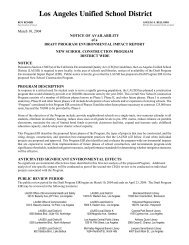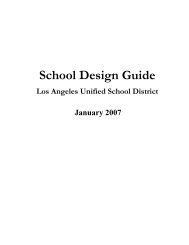Site-Specific Health and Safety Plan (HASP) - Laschools.org
Site-Specific Health and Safety Plan (HASP) - Laschools.org
Site-Specific Health and Safety Plan (HASP) - Laschools.org
Create successful ePaper yourself
Turn your PDF publications into a flip-book with our unique Google optimized e-Paper software.
LAUSD Proposed South Region High School #9 & Middle School #4<br />
6-2<br />
December 2006<br />
<strong>Site</strong> <strong>Specific</strong> <strong>Health</strong> & <strong>Safety</strong> <strong>Plan</strong> (<strong>HASP</strong>)<br />
• Well maintenace – Consists of replacement of well vaults <strong>and</strong> other miscellaneous<br />
repairs.<br />
• Well ab<strong>and</strong>onment - Ab<strong>and</strong>onment consists of removal of the entire well casing by overdrilling<br />
then filling the open borehole with grout under pressure.<br />
• Well drilling <strong>and</strong> well installation - Consists of drilling boreholes using both a hollowstem<br />
auger rig <strong>and</strong> a dual air percussion rig, drilling through aquifers to final depth,<br />
logging, identification of aquifer boundaries, assembly <strong>and</strong> placement of well<br />
casing/screening, filling of annulus with gravel pack, <strong>and</strong> sealing of annulus.<br />
• Well development - Consists of using a bailer to remove gross fines that accumulate<br />
while surging/swabbing the well, followed by a submersible pump to remove additional<br />
fines while pumping the well at variable rates <strong>and</strong> durations. These procedures stabilize<br />
the filter pack <strong>and</strong> remove fines from the filter pack to allow representative groundwater<br />
samples to be collected.<br />
• Groundwater sampling <strong>and</strong> aquifer pump testing – Consists of opening monitoring well<br />
caps, measuring water levels with a water level meter, purging groundwater with an<br />
electric pump, <strong>and</strong> collecting groundwater samples.<br />
Potential Hazards - Heavy equipment hazards from being struck by or against moving<br />
equipment, mechanical parts, <strong>and</strong> drill rigs; being caught <strong>and</strong> injured from moving equipment<br />
parts; lifting hazards from lifting <strong>and</strong> carrying materials; slip, fall, <strong>and</strong> trip hazards from walking<br />
on slippery <strong>and</strong> uneven surfaces; traffic safety hazards from working near roadways <strong>and</strong><br />
vehicles; cuts, skin abrasions, <strong>and</strong> bruises from h<strong>and</strong>ling of sharp tools or objects; noise hazards<br />
from working near a drill rig <strong>and</strong> other noise generating equipment; electrical hazards from<br />
improper use <strong>and</strong> h<strong>and</strong>ling of electrical devices; overhead hazards <strong>and</strong> excavation hazards<br />
(underground utilities); skin contact with contaminated soil or groundwater if groundwater is<br />
encountered during drilling; exposures to hazardous gases/vapor <strong>and</strong> particulates during well<br />
drilling <strong>and</strong> installation; <strong>and</strong> heat stress when working in a hot environment.<br />
Task 3 – Soil vapor sampling: This task includes opening monitoring well caps <strong>and</strong> collecting<br />
soil gas samples from various soil vapor monitoring points or installing temporary monitoring<br />
points using a Geoprobe®. Samples are collected using a calibrated flow meter <strong>and</strong> vacuum<br />
gauge. The actual samples are withdrawn from the moving sample stream using a glass syringe<br />
fitted with a disposable needle <strong>and</strong> Mininert TM gas-tight valve. Samples are analyzed<br />
immediately following collection, by direct gas injection into a laboratory-grade, field-operable<br />
gas chromatograph (by mobile laboratory). Alternatively, summa canisters may be used with<br />
analysis at an off-site laboratory.<br />
Potential Hazards - Heavy equipment hazards from being struck by/against moving equipment<br />
<strong>and</strong> vehicles; lifting hazards from lifting <strong>and</strong> carrying materials; slip, fall <strong>and</strong> trip hazards from<br />
walking on slippery <strong>and</strong> uneven surfaces; cuts, skin abrasions, <strong>and</strong> bruises during opening of<br />
well caps <strong>and</strong> h<strong>and</strong>ling of syringes, sharp tools/objects; improper work practices <strong>and</strong> procedures;<br />
hazardous vapor exposures during initial opening of the well cap <strong>and</strong> during vapor sampling; <strong>and</strong><br />
heat stress when working in a hot environment.<br />
193







